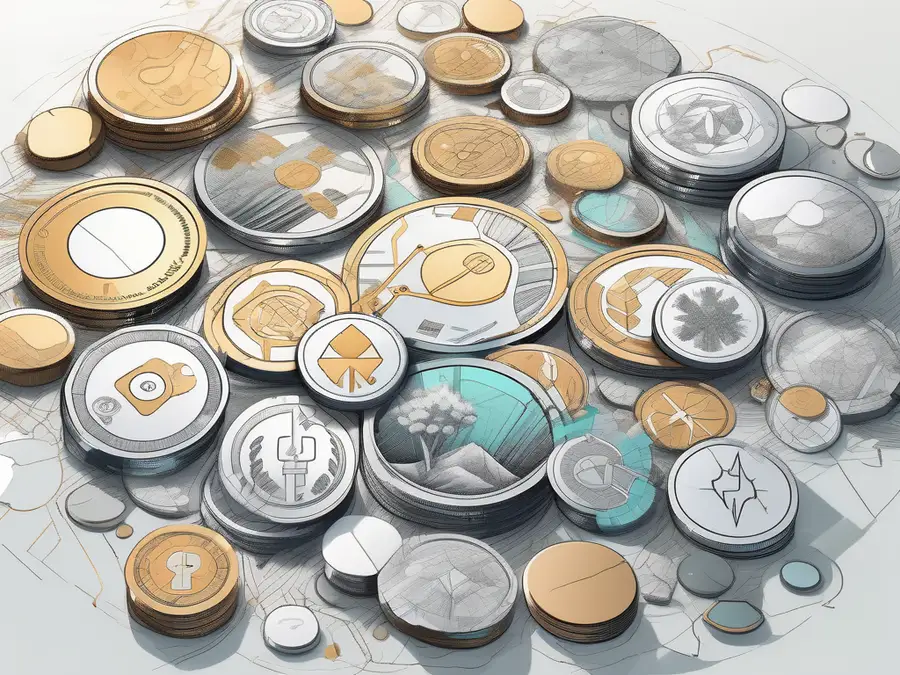What Is a Native Token? Understanding Its Role in Blockchain Ecosystems

As a blockchain enthusiast and an expert in the field, I'm excited to share with you the ultimate guide to native tokens. Native tokens are an essential part of the blockchain ecosystem, and understanding their concept and value can greatly enhance your understanding of this revolutionary technology.
Understanding the Concept of Native Tokens
Native tokens are digital assets that are native to a particular blockchain platform. They are created and exist solely within the blockchain ecosystem, serving various functions depending on their design and purpose.
Native tokens can represent a unit of value, ownership, or provide access to certain features and services within the blockchain network. They can be used for transactions, incentivizing network participants, or even for governance purposes.
Definition and Function of Native Tokens
Let's dive deeper into the definition and function of native tokens. A native token is a digital asset that is specific to a particular blockchain platform. It is typically created during the initial launch of the blockchain network and serves as the primary medium of exchange within that ecosystem.
The function of native tokens can vary depending on the blockchain platform they are associated with. They can serve as a means of payment, a store of value, or even represent fractional ownership in a digital asset. Native tokens can also provide utility, giving holders access to certain features or services within the blockchain network.
The Role of Native Tokens in Blockchain
Native tokens play a vital role in the functioning and stability of blockchain networks. They help secure the network by incentivizing participants to validate transactions and maintain the decentralized nature of the blockchain ecosystem.
In addition, native tokens often facilitate economic and governance models within blockchain networks. By holding native tokens, users can participate in decision-making processes, influence protocol upgrades, and even receive rewards for their contributions.
The Different Types of Native Tokens
Now that we understand the core concept of native tokens, let's explore the different types that exist in the blockchain world.
Utility Tokens
Utility tokens are native tokens that provide access to certain functionalities or services within a blockchain network. They can be used to pay transaction fees, access decentralized applications (DApps), or participate in specific network activities. Utility tokens have become increasingly popular, enabling developers to create ecosystems where token holders can benefit from the platform's unique features.
Governance Tokens
Governance tokens give holders the power to influence decision-making processes within a blockchain network. By owning and staking these tokens, users can vote on proposals, participate in consensus mechanisms, and shape the direction of the platform's development. Governance tokens empower token holders to take an active role in the governance of the blockchain ecosystem.
Security Tokens
Security tokens represent ownership in a real-world asset, such as equity in a company or rights to revenue or dividends. Unlike utility and governance tokens, security tokens are subject to securities regulations and require compliance with relevant financial authorities.
While utility and governance tokens are prevalent in the blockchain space, security tokens have been gaining traction as a way to tokenize traditional financial assets, bringing efficiency and liquidity to traditional markets.
The Process of Creating Native Tokens
Creating native tokens involves a well-defined process that ensures their legitimacy and functionality. Let's explore the steps involved in bringing native tokens to life.
Token Generation Events
A token generation event (TGE) is the initial sale or distribution of native tokens. During a TGE, tokens are created and offered to the public or a select group of investors. This process allows blockchain projects to raise funds for their development and operations.
It's important to conduct thorough research before participating in a TGE to understand the project's goals, team, and long-term potential. Analyzing the project's whitepaper, team experience, and roadmap can provide valuable insights to help you make informed decisions.
Expert Advice: Before participating in a TGE, carefully evaluate the project, its team, and the potential of the native tokens. Only invest what you can afford to lose and diversify your cryptocurrency portfolio. Remember, the cryptocurrency market can be volatile, and it's crucial to make informed investment choices.
Token Distribution Methods
Once native tokens are created, they need to be distributed to participants. Token distribution methods can vary depending on the project's goals and circumstances. Common distribution methods include initial coin offerings (ICOs), initial exchange offerings (IEOs), and airdrops.
ICOs and IEOs involve selling tokens directly to investors in exchange for cryptocurrencies, such as Bitcoin or Ethereum. Airdrops, on the other hand, distribute tokens for free to eligible participants, often based on their existing cryptocurrency holdings or participation in specific activities.
Evaluating the Value of Native Tokens
Understanding the factors that influence the value of native tokens is crucial for investors and enthusiasts alike. Let's explore some key considerations when evaluating token value.
Factors Influencing Token Value
The value of native tokens can be influenced by various factors, including demand, utility, scarcity, project progress, and market sentiment. Demand for the token, driven by its utility and the project's potential impact, can significantly impact its value in the market.
Additionally, factors such as token supply, circulating supply, and total supply can affect token scarcity and, consequently, its value. Evaluating the project's progress, partnerships, and the team's ability to execute their vision also play a crucial role in understanding token value.
Understanding Tokenomics
Tokenomics refers to the economic model and design of a token. It encompasses various aspects, such as token distribution, utility, incentives, and governance mechanisms. Understanding the tokenomics of a project can provide insights into its long-term viability and potential value appreciation.
Tokenomics can vary widely from project to project. Some tokens may have a fixed supply, while others may have a deflationary or inflationary supply model. Incentives, such as staking rewards or token burns, can further impact the token's value and ecosystem dynamics.
How to Invest in Native Tokens
Investing in native tokens can be an exciting and potentially profitable endeavor. Here are some key steps to consider when venturing into the world of native token investments.
Researching Potential Token Investments
Thorough research is essential before investing in any native token. Evaluate the project's team, technology, use case, community, and adoption potential. Scrutinize the project's whitepaper, roadmap, and progress to assess its long-term viability and potential return on investment.
Engaging with the project's community through forums, social media, and events can provide valuable insights and a better understanding of the token's ecosystem. Knowledge is power when it comes to investing, so take the time to educate yourself and make informed investment decisions.
Risks and Rewards of Token Investment
Investing in native tokens comes with its own set of risks and rewards. The cryptocurrency market is highly volatile, and prices can fluctuate dramatically in short periods. It's essential to evaluate your risk tolerance and only invest what you can afford to lose.
However, with great risks come great rewards. Successful investments in native tokens have the potential for significant returns and can contribute to the growth and development of groundbreaking blockchain projects.
FAQs
What are native tokens?
Native tokens are digital assets that are specific to a particular blockchain platform. They are created and exist solely within the blockchain ecosystem, serving various functions depending on their design and purpose.
What is the role of native tokens in blockchain?
Native tokens play a vital role in securing the network, facilitating economic and governance models, and providing access to features and services within the blockchain ecosystem.
What are the different types of native tokens?
There are three main types of native tokens: utility tokens, governance tokens, and security tokens. Utility tokens provide access to functionalities and services, governance tokens influence decision-making processes, and security tokens represent ownership in real-world assets.
How can I invest in native tokens?
To invest in native tokens, you need to conduct thorough research on the project, its team, and its potential. Evaluate the token's utility, market demand, and long-term viability. Be mindful of the risks and rewards associated with cryptocurrency investments.
What factors influence the value of native tokens?
The value of native tokens can be influenced by factors such as demand, utility, scarcity, project progress, and market sentiment. Understanding tokenomics, the economic model and design of the token, also plays a crucial role in evaluating token value.
Any expert tips for investing in native tokens?
Before investing in native tokens, thoroughly research the project, its team, and the potential of the tokens. Only invest what you can afford to lose, diversify your cryptocurrency portfolio, and stay updated with the latest developments in the blockchain industry.
In conclusion, native tokens are the lifeblood of blockchain networks, enabling transactions, incentivizing participants, and shaping the direction of the ecosystem. Understanding their concept, value, and investment opportunities can empower you to navigate the exciting world of blockchain technology with confidence. Happy investing!
Ready to take your understanding of native tokens to the next level and apply it to real-world trading? Look no further than Morpher, the innovative trading platform that's revolutionizing investing through blockchain technology. With Morpher, you can trade a vast array of asset classes, including the very native tokens discussed in this guide, without the burden of fees or the constraints of liquidity. Embrace the power of fractional investing, short selling, and up to 10x leverage to maximize your trading strategies. Your safety is paramount with Morpher's non-custodial wallet, giving you full control over your funds. Experience the future of trading with Morpher's unique Virtual Futures and enjoy a trading experience like no other. Sign Up and Get Your Free Sign Up Bonus today to start trading on a platform that aligns with the innovative spirit of blockchain!

Disclaimer: All investments involve risk, and the past performance of a security, industry, sector, market, financial product, trading strategy, or individual’s trading does not guarantee future results or returns. Investors are fully responsible for any investment decisions they make. Such decisions should be based solely on an evaluation of their financial circumstances, investment objectives, risk tolerance, and liquidity needs. This post does not constitute investment advice.

Painless trading for everyone
Hundreds of markets all in one place - Apple, Bitcoin, Gold, Watches, NFTs, Sneakers and so much more.

Painless trading for everyone
Hundreds of markets all in one place - Apple, Bitcoin, Gold, Watches, NFTs, Sneakers and so much more.








